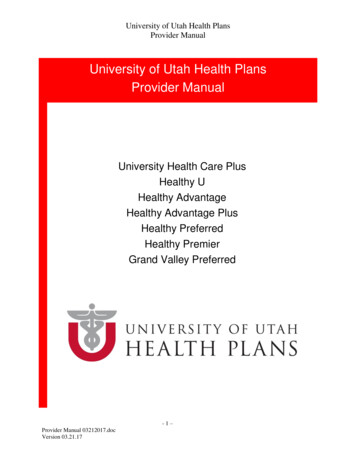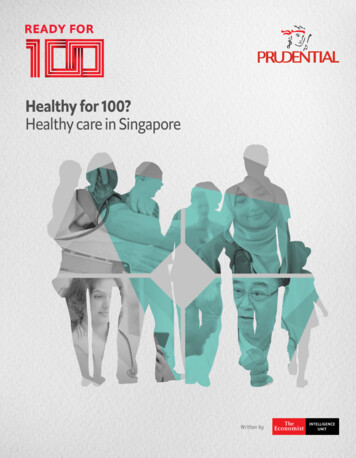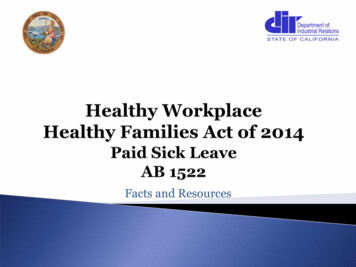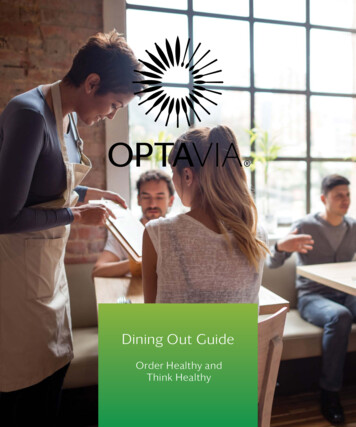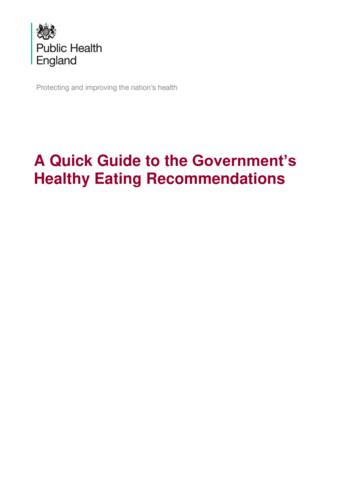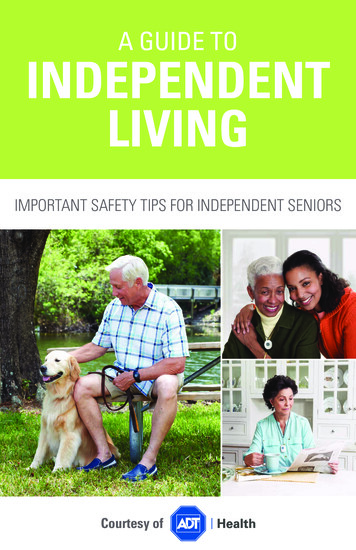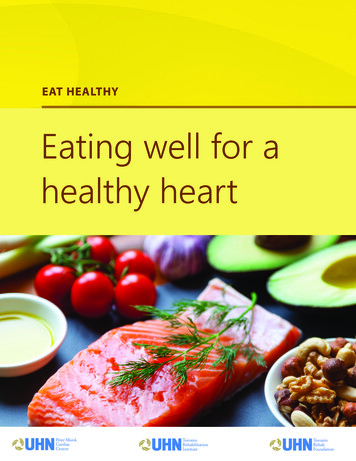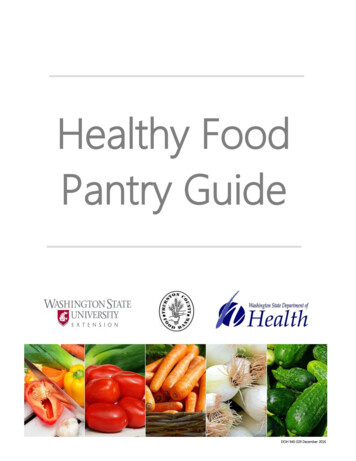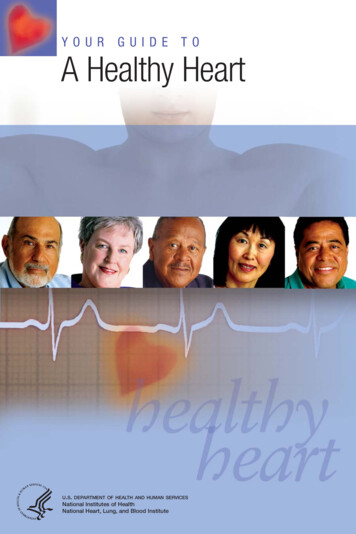
Transcription
YOURGUIDE TOA Healthy HeartU.S. DEPARTMENT OF HEALTH AND HUMAN SERVICESNational Institutes of HealthNational Heart, Lung, and Blood Institute
YOURGUIDE TOA Healthy HeartU.S. DEPARTMENTOFHEALTHANDHUMAN SERVICESNational Institutes of HealthNational Heart, Lung, and Blood InstituteNIH Publication No. 06-5269December 2005
Written by: Marian SandmaierU.S. DEPARTMENT OF HEALTH AND HUMAN SERVICESNational Institutes of HealthNational Heart, Lung, and Blood Institute
ContentsHeart Disease: Why Should You Care? . . . . . . . . . . . . . . . . . . . . . . . . . . . . 1What You Need To Know About Heart Disease . . . . . . . . . . . . . . . . . . . . . . 3What Is Heart Disease?. . . . . . . . . . . . . . . . . . . . . . . . . . . . . . . . . . . . . . . . . 3Who Is at Risk? . . . . . . . . . . . . . . . . . . . . . . . . . . . . . . . . . . . . . . . . . . . . . . 4How Risk Works . . . . . . . . . . . . . . . . . . . . . . . . . . . . . . . . . . . . . . . . . . . . . 4What’s Your Risk? . . . . . . . . . . . . . . . . . . . . . . . . . . . . . . . . . . . . . . . . . . . . 5How To Talk With Your Doctor . . . . . . . . . . . . . . . . . . . . . . . . . . . . . . . . . . . . 5Major Risk Factors . . . . . . . . . . . . . . . . . . . . . . . . . . . . . . . . . . . . . . . . . . . 11Smoking . . . . . . . . . . . . . . . . . . . . . . . . . . . . . . . . . . . . . . . . . . . . . . . . . 11High Blood Pressure. . . . . . . . . . . . . . . . . . . . . . . . . . . . . . . . . . . . . . . . . . 12What Is Blood Pressure?. . . . . . . . . . . . . . . . . . . . . . . . . . . . . . . . . . . . . 13Understanding Risk . . . . . . . . . . . . . . . . . . . . . . . . . . . . . . . . . . . . . . . . 14Changing Your Lifestyle. . . . . . . . . . . . . . . . . . . . . . . . . . . . . . . . . . . . . . 14Taking Medication . . . . . . . . . . . . . . . . . . . . . . . . . . . . . . . . . . . . . . . . . 16High Blood Cholesterol . . . . . . . . . . . . . . . . . . . . . . . . . . . . . . . . . . . . . . . . 17Cholesterol and Your Heart . . . . . . . . . . . . . . . . . . . . . . . . . . . . . . . . . . . 17Getting Tested . . . . . . . . . . . . . . . . . . . . . . . . . . . . . . . . . . . . . . . . . . . . 19What’s Your Number?. . . . . . . . . . . . . . . . . . . . . . . . . . . . . . . . . . . . . . . 19HDL Cholesterol Level . . . . . . . . . . . . . . . . . . . . . . . . . . . . . . . . . . . . . . 20Heart Disease Risk and Your LDL Goal . . . . . . . . . . . . . . . . . . . . . . . . . . . 20A Special Type of Risk . . . . . . . . . . . . . . . . . . . . . . . . . . . . . . . . . . . . . . 21Your LDL Goal. . . . . . . . . . . . . . . . . . . . . . . . . . . . . . . . . . . . . . . . . . . . 22How To Lower Your LDL . . . . . . . . . . . . . . . . . . . . . . . . . . . . . . . . . . . . . 22Overweight and Obesity . . . . . . . . . . . . . . . . . . . . . . . . . . . . . . . . . . . . . . . 24Should You Choose To Lose? . . . . . . . . . . . . . . . . . . . . . . . . . . . . . . . . . 26Lose a Little, Win a Lot . . . . . . . . . . . . . . . . . . . . . . . . . . . . . . . . . . . . . . 30Physical Inactivity . . . . . . . . . . . . . . . . . . . . . . . . . . . . . . . . . . . . . . . . . . . . 30Diabetes . . . . . . . . . . . . . . . . . . . . . . . . . . . . . . . . . . . . . . . . . . . . . . . . . 32ContentsWhat Else Affects Heart Disease?. . . . . . . . . . . . . . . . . . . . . . . . . . . . . . . 36Stress . . . . . . . . . . . . . . . . . . . . . . . . . . . . . . . . . . . . . . . . . . . . . . . . . 36Alcohol . . . . . . . . . . . . . . . . . . . . . . . . . . . . . . . . . . . . . . . . . . . . . . . . . 36Sleep Apnea . . . . . . . . . . . . . . . . . . . . . . . . . . . . . . . . . . . . . . . . . . . . . . . 39Menopausal Hormone Therapy . . . . . . . . . . . . . . . . . . . . . . . . . . . . . . . . . . 39Birth Control Pills . . . . . . . . . . . . . . . . . . . . . . . . . . . . . . . . . . . . . . . . . . . . 43
ivTaking Charge: An Action Plan for Heart Health . . . . . . . . . . . . . . . . . . . 45Choose Healthy Foods . . . . . . . . . . . . . . . . . . . . . . . . . . . . . . . . . . . . . . . . 45Getting Extra Support . . . . . . . . . . . . . . . . . . . . . . . . . . . . . . . . . . . . . . . . . 46Blood Pressure and the Dash Eating Plan . . . . . . . . . . . . . . . . . . . . . . . . . 48What Else Affects Blood Pressure? . . . . . . . . . . . . . . . . . . . . . . . . . . . . . . . . 53High Blood Cholesterol and the TLC Program . . . . . . . . . . . . . . . . . . . . . . . . 53Now You’re Cooking: Limiting Saturated Fat, Trans Fat, and Cholesterol . . . . . . 53Meat, Poultry, and Fish . . . . . . . . . . . . . . . . . . . . . . . . . . . . . . . . . . . . . . 53Milk Products and Eggs . . . . . . . . . . . . . . . . . . . . . . . . . . . . . . . . . . . . . 54Grains and Grain Products. . . . . . . . . . . . . . . . . . . . . . . . . . . . . . . . . . . . 55Sauces, Soups, and Casseroles . . . . . . . . . . . . . . . . . . . . . . . . . . . . . . . . 55When You Can’t Face Cooking. . . . . . . . . . . . . . . . . . . . . . . . . . . . . . . . . . . 56Dining Out for Health . . . . . . . . . . . . . . . . . . . . . . . . . . . . . . . . . . . . . . . 56Make Healthy Choices . . . . . . . . . . . . . . . . . . . . . . . . . . . . . . . . . . . . . . 57How To Tame a Snack Attack . . . . . . . . . . . . . . . . . . . . . . . . . . . . . . . . . 58Aim for a Healthy Weight. . . . . . . . . . . . . . . . . . . . . . . . . . . . . . . . . . . . . . . 61Getting Started . . . . . . . . . . . . . . . . . . . . . . . . . . . . . . . . . . . . . . . . . . . 63Seven Secrets of Weight Management . . . . . . . . . . . . . . . . . . . . . . . . . . . 64How To Choose a Weight-Loss Program . . . . . . . . . . . . . . . . . . . . . . . . . . 70Get Moving! . . . . . . . . . . . . . . . . . . . . . . . . . . . . . . . . . . . . . . . . . . . . . . . 72A Little Activity Goes a Long Way . . . . . . . . . . . . . . . . . . . . . . . . . . . . . . . 72No Sweat!. . . . . . . . . . . . . . . . . . . . . . . . . . . . . . . . . . . . . . . . . . . . . . . 73Safe Moves. . . . . . . . . . . . . . . . . . . . . . . . . . . . . . . . . . . . . . . . . . . . . . 74What’s Your Excuse? . . . . . . . . . . . . . . . . . . . . . . . . . . . . . . . . . . . . . . . 75Move It and Lose It . . . . . . . . . . . . . . . . . . . . . . . . . . . . . . . . . . . . . . . . 76You Can Stop Smoking. . . . . . . . . . . . . . . . . . . . . . . . . . . . . . . . . . . . . . . . 76Prepare To Succeed. . . . . . . . . . . . . . . . . . . . . . . . . . . . . . . . . . . . . . . . 78Breaking the Habit . . . . . . . . . . . . . . . . . . . . . . . . . . . . . . . . . . . . . . . . . 78If You “Slip” . . . . . . . . . . . . . . . . . . . . . . . . . . . . . . . . . . . . . . . . . . . . . . 81Heart Health Is a Family Affair . . . . . . . . . . . . . . . . . . . . . . . . . . . . . . . . . 83A Change of Heart . . . . . . . . . . . . . . . . . . . . . . . . . . . . . . . . . . . . . . . . . . . 85Your Guide to a Healthy HeartHow To Estimate Your Risk . . . . . . . . . . . . . . . . . . . . . . . . . . . . . . . . . . . . 86To Learn More . . . . . . . . . . . . . . . . . . . . . . . . . . . . . . . . . . . . . . . . . . . . . . 88
1Heart Disease:Why Should You Care?If you’re like many people, you may think of heart disease as aproblem that happens to other folks. “I feel fine,” you may think,“so I have nothing to worry about.” If you’re a woman, you mayalso believe that being female protects you from heart disease.If you’re a man, you may think you’re not old enough to have aserious heart condition.Wrong on all counts. In the United States, heart disease is the #1killer of both women and men. It affects many people at midlife,as well as in old age. It also can happen to those who “feel fine.”Consider these facts: Each year, 500,000 Americans die of heart disease, and approximately half of them are women.As early as age 45, a man’s risk of heart disease begins to risesignificantly. For a woman, risk starts to increase at age 55.Fifty percent of men and 64 percent of women who die suddenlyof heart disease have no previous symptoms of the disease.Heart Disease: Why Should You Care?
2These facts may seem frightening, but they need not be. The goodnews is that you have a lot of power to protect and improve yourheart health. This guidebook will help you find out your own riskof heart disease and take steps to prevent it.“But,” you may still be thinking, “I take pretty good care of myself.I’m unlikely to get heart disease.” Yet a recent national survey showsthat only 3 percent of U.S. adults practice all of the “Big Four”habits that help to prevent heart disease: eating a healthy diet,getting regular physical activity, maintaining a healthy weight, andavoiding smoking. Many young people are also vulnerable. Arecent study showed that about two-thirds of teenagers already haveat least one risk factor for heart disease.Every risk factor counts. Research shows that each individual riskfactor greatly increases the chances of developing heart disease.Moreover, the worse a particular risk factor is, the more likely youare to develop heart disease. For example, if you have high bloodpressure, the higher it is, the greater your chances of developingheart disease, including its many serious consequences. A damagedheart can damage your life by interfering with enjoyable activities,preventing you from holding a job, and even keeping you fromdoing simple things, such as taking a walk or climbing steps.Your Guide to a Healthy HeartWhat can you do to reduce your personal risk of heart disease?First, you can learn about your own risk factors. Second, you canbegin to make healthful changes in your diet, physical activity, andother daily habits. Whatever your age or current state of health, it’snever too late to take steps to protect your heart. It’s also never tooearly. The sooner you act, the better. So use this guidebook to findout more about the state of your heart, and to learn about hearthealthy living. Talk with your doctor to get more information.Start taking action to improve your heart health today.
3What You Need To KnowAbout Heart DiseaseWhat Is Heart Disease?Coronary heart disease—often simply called heart disease—occurswhen the arteries that supply blood to the heart muscle becomehardened and narrowed due to a buildup of plaque on the arteries’inner walls. Plaque is the accumulation of fat, cholesterol, and othersubstances. As plaque continues to build up in the arteries, bloodflow to the heart is reduced.Heart disease can lead to a heart attack. A heart attack happenswhen an artery becomes totally blocked with plaque, preventingvital oxygen and nutrients from getting to the heart. A heart attackcan cause permanent damage to the heart muscle.Heart disease is one of several cardiovascular diseases, which aredisorders of the heart and blood vessel system. Other cardiovasculardiseases include stroke, high blood pressure, and rheumatic heartdisease.What You Need To Know About Heart DiseaseSome people aren’t too concerned about heart disease because theythink it can be “cured” with surgery. This is a myth.Heart disease is a lifelong condition: Once you get it,you’ll always have it. It’s true that procedures such asangioplasty and bypass surgery can help blood andoxygen flow more easily to the heart. But the arteries remain damaged, which means you are still morelikely to have a heart attack. What’s more, thecondition of your blood vessels will steadilyworsen unless you make changes in yourdaily habits and control your risk factors.Many people die of complicationsfrom heart disease, or becomepermanently disabled. That’swhy it is so vital to take action toprevent this disease.
4Who Is at Risk?Risk factors are conditions or habits that make a person more likelyto develop a disease. They can also increase the chances that anexisting disease will get worse. Important risk factors for heart disease that you can do something about are cigarette smoking, highblood pressure, high blood cholesterol, overweight, physicalinactivity, and diabetes. Recent research shows that more than95 percent of those who die from heart disease have at least oneof these major risk factors.Certain risk factors, such as getting older, can’t be changed. Aftermenopause, women are more likely to develop heart disease. Forboth women and men, middle age is a time of increasing riskbecause people are more likely to develop heart disease risk factorsduring this stage of life.Family history of early heart disease is another risk factor that can’tbe changed. If your father or brother had a heart attack before age55, or if your mother or sister had one before age 65, you are morelikely to get heart disease.While certain risk factors cannot be changed, it is important torealize that you do have control over many others. Regardless ofyour age or family history, you can take important steps to loweryour risk of heart disease.Your Guide to a Healthy HeartHow Risk WorksIt may be tempting to believe that doing just one healthy thing willtake care of your heart disease risk. For example, you may hopethat if you walk or swim regularly, you can still eat a lot of fattyfoods and stay fairly healthy. Not true. To protect your heart, it isvital to make changes that address each and every risk factor youhave. You can make the changes gradually, one at a time. But making them is very important.While each risk factor increases your risk of heart disease, havingmore than one risk factor is especially serious. That’s because riskfactors tend to “gang up” and worsen each other’s effects. Forexample, if you have high blood cholesterol and you smoke, yourheart disease risk increases enormously. The message is clear: Youneed to take heart disease risk seriously, and the best time to reducethat risk is now.
5What’s Your Risk?The first step toward heart health is becoming aware of yourown personal risk for heart disease. Some risks, such as smokingcigarettes or being overweight, are obvious: All of us know whetherwe smoke or whether we need to lose a few pounds. But other riskfactors, such as high blood pressure or high blood cholesterol, havefew visible signs or symptoms. So you’ll need to gather someinformation to create your own personal “heart profile.”How To Talk With Your DoctorThe first step in finding out your risk is to make an appointmentwith your doctor for a thorough checkup. Your physician can bean important partner in helping you set and reach goals for hearthealth. But don’t wait for your doctor to mention heart disease orits risk factors. Many physicians don’t routinely bring up the topic,especially with their female patients. New research shows thatwomen are less likely than men to receive heart healthy recommendations from their doctors. Here’s how to speak up and establishgood, clear communication between you and your doctor.Ask for what you need. Tell your doctor that you want to keep yourheart healthy and would like help in achieving thatgoal. Ask questions about your chances ofdeveloping heart disease and ways to loweryour risk. (See “Questions To Ask YourDoctor” on the next page.) Also ask fortests that will determine your personalrisk factors. (See “What’s Your Number?”on page 8.)What’s Your Risk?Be open. When your doctor asks youquestions, answer them ashonestly and fully as youcan. While certain topicsmay seem quite personal,
6discussing them openly can help your doctor find out your chances ofdeveloping heart disease. It can also help your doctor work more effectively with you to reduce your risk.Keep it simple. If you don’t understand something your doctor says,ask for an explanation in plain language. Be especially sure youunderstand why and how to take any medication you’re given. Ifyou are worried about understanding what the doctor says, or if youhave trouble hearing, bring a friend or relative with you to yourappointment. You may want to ask that person to write down thedoctor’s instructions for you.Questions ToAsk Your DoctorYour Guide to a Healthy HeartGetting answers to these questions will give you important information about your heart health and what you can do to improveit. You may want to bring this list to your doctor’s office.1. What is my risk for heart disease?2. What is my blood pressure? What does it mean for me, andwhat do I need to do about it?3. What are my cholesterol numbers? (These include totalcholesterol, low-density lipoprotein (LDL) “bad” cholesterol,high-density lipoprotein (HDL) “good” cholesterol, andtriglycerides.) What do they mean for me, and what doI need to do about them?4. What are my body mass index (BMI) and waist measurement?Do they indicate that I need to lose weight for my health?5. What is my blood sugar level? Does it mean I’m at risk fordiabetes?6. What other screening tests for heart disease do I need? Howoften should I return for checkups for my heart health?7. For smokers: What can you do to help me quit smoking?8. How much physical activity do I need to help protect myheart? What kinds of activities are helpful?9. What is a heart healthy eating plan for me? Should I see aregistered dietitian or qualified nutritionist to learn more abouthealthy eating?10. How can I tell if I’m having a heart attack?
7ANNSTIEGLER“I just didn’t think I could be having aheart attack. I didn’t expect it to happento me. I was overweight and had highcholesterol but thought I was in goodhealth. I’d had diabetes about 4 years, butI had no idea that it was a risk factor forheart disease. Most women don’t knowthey’re at risk for heart disease. I haveseveral friends who have a lot of thesame risk factors that I do, but they’rejust not tuned in to them. They need toknow that, and they need to take bettercare of themselves.”What’s Your Risk?
8What’s Your Number?Tests That Can HelpProtect Your HealthAsk your doctor to give you these tests. Each one will give youvaluable information about your heart disease risk.Lipoprotein ProfileWhat: A blood test that measures total cholesterol, LDL “bad”cholesterol, HDL “good” cholesterol, and triglycerides (another formof fat in the blood). The test is given after a 9- to 12-hour fast.Why: To find out if you have any of the following: high bloodcholesterol (high total and LDL cholesterol), low HDL cholesterol,or high triglyceride levels. All affect your risk for heart disease.When: All healthy adults should have a lipoprotein profile doneat least once every 5 years. Depending on the results, yourdoctor may want to repeat the test more frequently.Blood PressureWhat: A simple, painless test using an inflatable arm cuff.Why: To find out if you have high blood pressure (also called hypertension) or prehypertension. Both are risk factors for heart disease.Your Guide to a Healthy HeartWhen: At least every 2 years, or more often if you have highblood pressure or prehypertension.Fasting Plasma GlucoseWhat: The preferred test for diagnosing diabetes. After you havefasted overnight, you will be given a blood test the following morning.
9Why: To find out if you have diabetes or are likely to develop thedisease. Fasting plasma glucose levels of 126 mg/dL or higher intwo tests on different days mean that you have diabetes. Levelsbetween 100 and 125 mg/dL mean that you have an increasedrisk of developing diabetes and may have prediabetes. Diabetesis an important risk factor for heart disease and other medicaldisorders.When: At least every 3 years, beginning at age 45. If you haverisk factors for diabetes, you should be tested at a younger ageand more often.Body Mass Index (BMI) and Waist CircumferenceWhat: BMI is a measure of your weight in relation to your height.Waist circumference is a measure of the fat around your middle.Why: To find out if your body type raises your risk of heart disease. A BMI of 25 or higher means you are overweight. A BMI of30 or higher means you are obese. Both overweight andobesity are risk factors for heart disease. For women, a waistmeasurement of more than 35 inches increases the risk of heartdisease and other serious health conditions. For men, a waistmeasurement of more than 40 inches increases risk.When: Every 2 years, or more often if your doctor recommends it.What’s Your Number?What’s Your Risk?There are also several tests that can determine whether youalready have heart disease. Ask your doctor whether you need astress test, an electrocardiogram (ECG or EKG), or anotherdiagnostic test.
10RatingYour RiskHere is a quick quiz to find out if you have an increased risk for aheart attack. If you don’t know some of the answers, ask yourhealth care provider. Your Guide to a Healthy Heart Do you smoke?Is your blood pressure 140/90 mmHg or higher; OR, have youbeen told by your doctor that your blood pressure is too high?Has your doctor told you that your LDL “bad” cholesterol istoo high; that your total cholesterol level is 200 mg/dL or higher;OR, that your HDL “good” cholesterol is less than 40 mg/dL?Has your father or brother had a heart attack before age 55;OR, has your mother or sister had one before age 65?Do you have diabetes OR a fasting blood sugar of 126 mg/dLor higher; OR, do you need medicine to control your blood sugar?For women: Are you over 55 years old?For men: Are you over 45 years old?Do you have a Body Mass Index score of 25 or more? (To findout, see page 27.)Do you get less than a total of 30 minutes of physical activityon most days?Has a doctor told you that you have angina (chest pains);OR, have you had a heart attack?If you answered “yes” to any of thesequestions, you have a higher risk ofhaving a heart attack. Read on tolearn what you can do to loweryour risk.Rating YourRisk
11Major Risk FactorsA strong partnership with your doctor is a vital first step in protecting your heart health. But to make a lasting difference, you’ll alsoneed to learn more about heart disease and the kinds of habits andconditions that can increase your risk. It’s your heart, and you’re incharge. What follows is a guide to the most important risk factorsfor heart disease and how each of them affects your health.SmokingSmoking is “the leading cause of preventable death and diseasein the United States,” according to the Centers for Disease Controland Prevention (CDC). People who smoke are up to six times morelikely to suffer a heart attack than nonsmokers, and the risk increases with the number of cigarettes smoked each day. Smoking canalso shorten a healthy life, because smokers are likely to suffer aheart attack or other major heart problem at least 10 years soonerthan nonsmokers.But heart disease is far from the only health risk faced by smokers.Smoking also raises the risk of stroke and greatly increases thechances of developing lung cancer. Smoking is also linked withmany other types of cancer, including cancers of the mouth, urinarytract, kidney, and cervix. Smoking also causes most cases of chronicobstructive lung disease, which includes bronchitis and emphysema.If you live or work with others, your secondhand smoke can causenumerous health problems in those individuals. A recent studyshows a 60-percent increased risk of heart disease for nonsmokerswho are regularly exposed to secondhand smoke.Major Risk FactorsCurrently, 25 percent of American men and 20 percent of Americanwomen are smokers. Even more disturbing, 26 percent of highschool seniors smoke. In young people, smoking can interfere withlung growth and cause more frequent and severe respiratory illnesses,in addition to heart disease and cancer risks. The younger people
12start smoking cigarettes, the more likely they are to become stronglyaddicted to nicotine.There is simply no safe way to smoke. Low-tar and low-nicotinecigarettes do not lessen the risks of heart disease or other smokingrelated diseases. The only safe and healthful course is not to smoke atall. (For tips on quitting, see “You Can Stop Smoking” on page 76.)High Blood PressureHigh blood pressure, also known as hypertension, is another majorrisk factor for heart disease, as well as for kidney disease and congestive heart failure. High blood pressure is also the most importantrisk factor for stroke. Even slightly high blood pressure levelsincrease your risk for these conditions.New research shows that at least 65 million adults in the UnitedStates have high blood pressure—a 30-percent increase over the lastseveral years. Equally worrisome, blood pressure levels haveincreased substantially for American children and teens, whichincreases their risk of developing hypertension in adulthood.Your Guide to a Healthy HeartMajor contributors to high blood pressure are a family history ofthe disease, overweight, and dietary salt. Older individuals are athigher risk than younger people. Among older individuals, womenare more likely than men to develop high blood pressure. AfricanAmericans are more likely to develop high blood pressure, and atearlier ages, than Whites. But nearly all of us are at risk, especiallyas we grow older. Middle-aged Americans who don’t currentlyhave high blood pressure have a 90-percent chance of eventuallydeveloping the disease.High blood pressure is often called the silent killer because itusually doesn’t cause symptoms. As a result, many people pay littleattention to their blood pressure until they become seriously ill.According to a national survey, two-thirds of people with highblood pressure do not have it under control. The good news is thatyou can take action to control or prevent high blood pressure, andthereby avoid many life-threatening disorders. A new blood pressure category, called prehypertension, has been created to alert people to their increased risk of developing high blood pressure so thatthey can take steps to prevent the disease.
13What Is Blood Pressure?Blood pressure is the amount of force exerted by the blood againstthe walls of the arteries. Everyone has to have some blood pressure,so that blood can get to all of the body’s organs. Usually, bloodpressure is expressed as two numbers, such as 120/80, and ismeasured in millimeters of mercury (mmHg). The first numberis the systolic blood pressure, the amount of force used when theheart beats. The second number, or diastolic blood pressure, is thepressure that exists in the arteries between heartbeats.Because blood pressure changes often, your health care providershould check it on several different days before deciding whether it istoo high. Blood pressure is considered “high” when it stays aboveprehypertensive levels over a period of time. (See accompanying box.)Your Blood Pressure:Crunching the NumbersYour blood pressure category is determined by the highernumber of either your systolic or your diastolic measurement.For example, if your systolic number is 115 but your diastolicnumber is 85, your category is prehypertension.SystolicDiastolicNormal blood pressureLess than120 mmHgandLess than80 mmHgPrehypertension120–139mmHgor80–89 mmHgHigh blood pressure140 mmHgor higheror90 mmHgor higherMajor Risk FactorsBlood Pressure
14Understanding RiskIt’s important to understand what each of these categories means.High blood pressure, of course, increases heart disease risk morethan any other category. But many people don’t realize that thesecond category—prehypertension—also increases your risk of heartattack, stroke, and heart failure. To the extent possible, everyoneshould aim for normal blood pressure levels.Be aware, too, that a high systolic blood pressure level (first number)is dangerous. If your systolic blood pressure is 140 mmHg or higher, you are more likely to develop cardiovascular and kidney diseaseseven if your diastolic blood pressure (second number) is in thenormal range. After age 50, people are more likely to develop highsystolic blood pressure. High systolic blood pressure is high bloodpressure. If you have this condition, you will need to take steps tocontrol it. High blood pressure can be controlled in two ways: bychanging your lifestyle and by taking medication.Your Guide to a Healthy HeartChanging Your LifestyleIf your blood pressure is not too high, you may be able to controlit entirely by losing weight if you are overweight, getting regularphysical activity, cutting down on alcohol, and changing your eatinghabits. A special eating plan called DASH can help you lower yourblood pressure. DASH stands for “Dietary Approaches to StopHypertension.” The DASH eating plan emphasizes fruits, vegetables, whole-grain foods, and low-fat or fat-free milk and milk products.It is rich in magnesium, potassium, and calcium, as well as proteinand fiber. It is low in saturated and total fat and cholesterol, andlimits red meat, sweets, and beverages with added sugars.If you follow the DASH eating plan and also consume less sodium,you are likely to reduce your blood pressure even more. Sodium is asubstance that affects blood pressure. It is the main ingredient insalt and is found in many processed foods, such as soups, convenience meals, some breads and cereals, and salted snacks.For more on the DASH eating plan and other changes you can maketo lower and prevent high blood pressure, see the “Taking Charge”section of this guidebook (pages 45–82.)
15JOSE“HENRIQUEZThe doctor sent me to a dietitian. She is the onewho taught me the things that I had to do inorder to eat right. It was hard at the beginningbecause once you have bad habits, they arehard to break. But, once I realized it was for myown good and no one was going to take care ofme except me, I decided to start eating better.”Major Risk Factors
16Taking MedicationIf your blood pressure remains high even after you make lifestylechanges, your doctor will probably prescribe medicine. Lifestylechanges will help the medicine work more effectively. In fact, if youare successful with the changes you make in your daily habits, you
heart health. This guidebook will help you find out your own risk of heart disease and take steps to prevent it. “But,” you may still be thinking, “I take pretty good care of myself. I’m unlikely to get heart d
